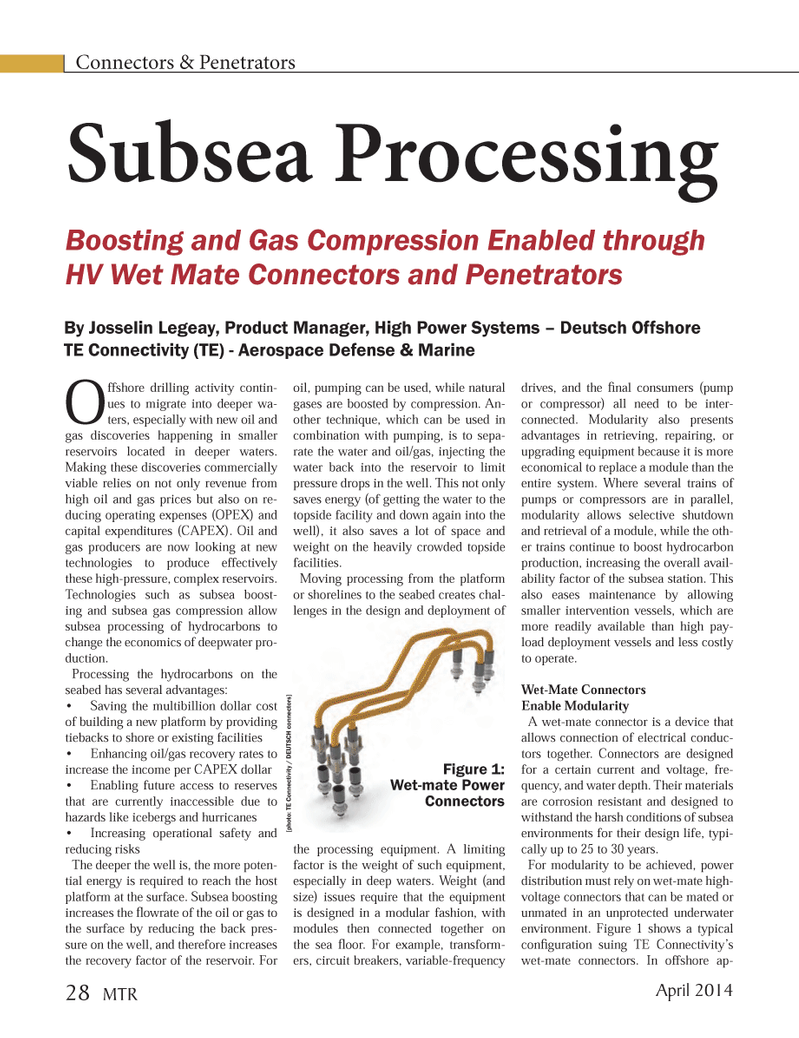
Page 28: of Marine Technology Magazine (April 2014)
Offshore Energy
Read this page in Pdf, Flash or Html5 edition of April 2014 Marine Technology Magazine
Connectors & Penetrators
O ffshore drilling activity contin- ues to migrate into deeper wa- ters, especially with new oil and gas discoveries happening in smaller reservoirs located in deeper waters.
Making these discoveries commercially viable relies on not only revenue from high oil and gas prices but also on re- ducing operating expenses (OPEX) and capital expenditures (CAPEX). Oil and gas producers are now looking at new technologies to produce effectively these high-pressure, complex reservoirs.
Technologies such as subsea boost- ing and subsea gas compression allow subsea processing of hydrocarbons to change the economics of deepwater pro- duction.
Processing the hydrocarbons on the seabed has several advantages: Saving the multibillion dollar cost of building a new platform by providing tiebacks to shore or existing facilities Enhancing oil/gas recovery rates to increase the income per CAPEX dollar Enabling future access to reserves that are currently inaccessible due to hazards like icebergs and hurricanes Increasing operational safety and reducing risks
The deeper the well is, the more poten- tial energy is required to reach the host platform at the surface. Subsea boosting increases the fl owrate of the oil or gas to the surface by reducing the back pres- sure on the well, and therefore increases the recovery factor of the reservoir. For oil, pumping can be used, while natural gases are boosted by compression. An- other technique, which can be used in combination with pumping, is to sepa- rate the water and oil/gas, injecting the water back into the reservoir to limit pressure drops in the well. This not only saves energy (of getting the water to the topside facility and down again into the well), it also saves a lot of space and weight on the heavily crowded topside facilities.
Moving processing from the platform or shorelines to the seabed creates chal- lenges in the design and deployment of the processing equipment. A limiting factor is the weight of such equipment, especially in deep waters. Weight (and size) issues require that the equipment is designed in a modular fashion, with modules then connected together on the sea fl oor. For example, transform- ers, circuit breakers, variable-frequency drives, and the fi nal consumers (pump or compressor) all need to be inter- connected. Modularity also presents advantages in retrieving, repairing, or upgrading equipment because it is more economical to replace a module than the entire system. Where several trains of pumps or compressors are in parallel, modularity allows selective shutdown and retrieval of a module, while the oth- er trains continue to boost hydrocarbon production, increasing the overall avail- ability factor of the subsea station. This also eases maintenance by allowing smaller intervention vessels, which are more readily available than high pay- load deployment vessels and less costly to operate.
Wet-Mate Connectors
Enable Modularity
A wet-mate connector is a device that allows connection of electrical conduc- tors together. Connectors are designed for a certain current and voltage, fre- quency, and water depth. Their materials are corrosion resistant and designed to withstand the harsh conditions of subsea environments for their design life, typi- cally up to 25 to 30 years.
For modularity to be achieved, power distribution must rely on wet-mate high- voltage connectors that can be mated or unmated in an unprotected underwater environment. Figure 1 shows a typical confi guration suing TE Connectivity’s wet-mate connectors. In offshore ap-
Subsea Processinga P cessin
Boosting and Gas Compression Enabled through
HV Wet Mate Connectors and Penetrators
By Josselin Legeay, Product Manager, High Power Systems – Deutsch Offshore
TE Connectivity (TE) - Aerospace Defense & Marine [photo: TE Connectivity / DEUT
SCH connector s]
Figure 1:
Wet-mate Power
Connectors 28 MTR
April 2014
MTR #3 (18-33).indd 28 4/10/2014 11:56:51 AM

 27
27

 29
29
